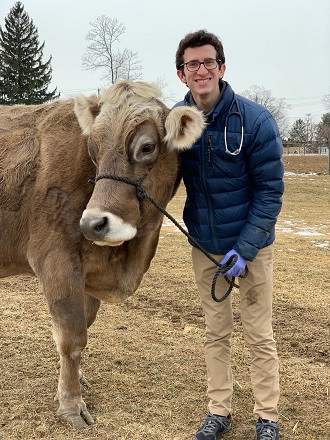Being an RVC Anatomic Pathology Resident
Clinical Connections – Summer 2022
At this end of his residency and before heading back to the USA, Kevin O’Brien spoke to Clinical Connections about his experience at the RVC.
What made you choose anatomic pathology as a specialty and what made you choose the RVC for your residency?
One of the best aspects of anatomic pathology is the versatility! We get to work with (just about) every species, and can work in sectors such as academia, government regulatory agencies, pharmaceutical companies, diagnostic laboratories, or zoos. Anatomic pathology also offers a great work-life balance that I think no other speciality matches. From no on-call or weekend duties to ample opportunities for remote work, it is a pretty enticing offer. Now that we have a slide scanner, all we need is a wi-fi connection to report our biopsy cases. One company told me during an interview that if I wanted to report cases from the beaches in Thailand, go for it, and that’s all I really needed to hear. Though obviously remote work doesn’t lend itself to postmortems – I’m not sure I want to bring that work home with me!

Why the RVC?
It is the top veterinary school in the world and its anatomic pathology department has a strong reputation with an excellent pass rate for the specialty ACVP exams. Also, I was itching to return to the UK.
What was your background prior to your residency?
I’m originally from New York and completed my bachelor’s degree in biology and chemistry at New York University in 2013. Then I deferred my veterinary school place at University of Pennsylvania for two years to pursue a biology fellowship in the United Arab Emirates. I graduated from Penn in May 2019 and I joined the RVC as an anatomic pathology resident two months later.
During veterinary school, I developed a strong interest in the parallels between animal and human health. I became involved with various research projects highlighting this relationship, such as working with the canine and porcine gastrointestinal microbiomes and inflammatory bowel disease as part of a collaboration with University of Pennsylvania and Children's Hospital of Philadelphia (PennCHOP) Microbiome Programme. After graduation, I sought out an anatomic pathology residency at the RVC with a focus on comparative pathology using animal models.
What are some of the most interesting things you have encountered during your residency?
Jaffa Cakes. I still don’t quite understand them, but I’m intrigued. But equally seriously, at the RVC I get to work with fantastic people from all over the world. Even within my own department, I work with people from Denmark, Greece, Slovenia, Germany, Canada, Ireland, Spain, the list goes on. Coming from the US, I am not used to this much geographic diversity!
In terms of interesting and exciting cases, I have had the opportunity to help out at the London and Whipsnade Zoos with one of their silverback gorillas and white rhinos. I have also had the opportunity to work with pathologists at King’s College London to observe postmortems in people and really hone the comparative anatomy elements of pathology.
What are the key challenges in the work?
The pandemic. This affected everyone, naturally, but our department (and the RVC as a whole) had to circumnavigate plenty of obstacles to get back into working order. However, for my department, it allowed us to take full advantage of our in-house slide scanner, which let us conduct didactic rounds from our homes, share digital slides to colleagues abroad, and allowed for a better work-life balance.
In general, though, autolysis can be the biggest obstacle we face on a day-to-day basis. When an animal dies, the body starts to break down on a cellular level (this accelerates in larger animals and on especially hot days), which makes it significantly more difficult for us to diagnose most lesions due to the tissue artefacts autolysis induces.
How would you like to see your career progressing after your specialist training?
I get a rush from teaching the intramural rotations students, so I would love to stay in academia for now. But who knows, anatomic pathology is a such a broad field and my training at the RVC will allow me to pursue any number of sectors if I change my mind.
At the moment, I am hoping to return to Penn with a comparative pathology position, so wish me luck!
